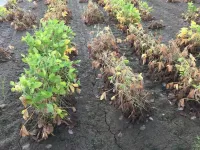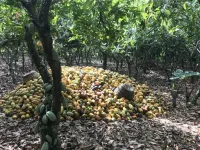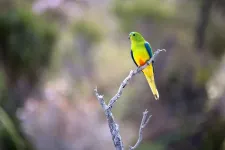Farmers who use zero-grade fields for rice as their main production system are also interested in flood-tolerant soybean varieties for crop rotation, said Caio Vieira, assistant professor of soybean breeding and a researcher for the Arkansas Agricultural Experiment Station, the University of Arkansas System Division of Agriculture’s research arm. Zero-grade fields are leveled to minimize drainage, a water-conservation strategy that has become a key sustainability practice in rice production.
Vieira is the lead author of a study offering more insight into how soybean plants respond to flooding in the critical early reproductive stage when the plant begins to flower. The study, “Impact of flooding at the early reproductive growth stage on soybean yield and seed composition,” was published in the journal Crop Science.
“Flooding research has focused on the early reproductive stage simply because it is when the stress is most pronounced and causes the greatest yield loss,” Vieira said. “Across the Mid-South, soybean is most susceptible to flooding at the R1 stage.”
R1 is the name given to the early flowering stage in soybean growth. There are eight stages of soybean plant reproductive growth, from R1 — beginning blooming — to R8 — full maturity.
Vieira said that temperature changes in the United States have allowed earlier soybean planting dates so that shifting rain patterns are also resulting in additional stress on the soybean plants. Soybeans are also highly sensitive to flooding during seed germination, the study explains.
“The intensity and frequency of rain has been shifting to earlier in the season,” he added. “We're pretty much getting the potential for flooding throughout the season. It's been tougher.”
Typically, soybeans in Arkansas are planted from early April to mid-May, which puts the R1 stage in late June to early July. As growers see the benefits of earlier planting, including improved yields, Vieira said, naturally, the early reproductive stage would also shift.
“It can be hit or miss,” Vieira said. “You can get a year where that period is a full-on drought, or you can get a year where that typical R1 period is completely wet with intensive rains. It's hard, hard to predict.”
Experiment station researchers have also worked to improve drought tolerance in soybeans.
Trend toward early planting Jeremy Ross, professor and extension soybean agronomist for the University of Arkansas System Division of Agriculture, said he has noticed more farmers planting earlier — at the end of February or early March instead of April and May.
“There’s been a big push to plant a month earlier than 10 years ago because we have data showing it leads up to 10 percentage points better production,” Ross said.
Early planting, Ross added, made possible by a shift in weather patterns, may assist in avoiding late-season insect problems and possibly outrun some hotter temperatures in July. An earlier harvest has also allowed those early planters to prepare their fields for the following season when the ground is dry in the fall. Unless, of course, remnants of hurricanes roll through Arkansas, as happened twice in September 2024.
Seed composition discovery While grain yield losses from flooding stress have been well documented, Vieira said there has been a gap in literature on the impact of flooding on soybean seed composition.
The study was conducted at the Division of Agriculture’s Rice Research and Extension Center in Stuttgart and compared 31 soybean genotypes over the 2019 and 2020 growing seasons. The plants were exposed to non-flooded and flooded conditions to look at yield and seed composition – specifically its oil and protein content.
A surprising discovery, Vieira said, was that four-day flooding in the early reproductive stage did not significantly alter the soybean seed composition of any of the varieties tested compared to the non-flooded control group.
Looks can be deceiving Visual inspection of flood-damaged soybeans has been useful, Vieira noted, but it doesn’t tell the whole story. The study found that some genotypes visually classified as “moderately tolerant” to flooding had higher yields than those classified as “tolerant.”
“Although flood tolerance has been shown to provide yield security under short-term flood exposure, losses are still observed in tolerant genotypes, and little is known regarding the stability of tolerance and the multitude of environmental effects of the trait,” the study noted. “The limitations of subjective visual scoring, combined with spatial variability, emphasize the need for novel and improved methods to accurately classify genotypic responses.”
On average, for each unit increase in flood damage score, the study showed that grain yield decreased by 17.4 percent. Tolerant genotypes experienced roughly 33 percent yield losses between flooding and non-flooding treatments, while “moderately” tolerant and “susceptible” genotypes experienced 44 percent and 51 percent yield losses, respectively.
Vieira said the study will help his team identify and incorporate flood-tolerant characteristics into future soybean genetics, potentially mitigating flooding-induced yield losses across diverse environmental conditions.
Co-authors of the study included Arkansas Agricultural Experiment Station program associates Chengjun Wu, Liliana Florez-Palacios, Andrea Acuna and Derrick Harrison; program technician Daniel Rogers; former experiment station faculty member Leandro Mozzoni; and John Carlin, director of the Arkansas Crop Variety Improvement Program. Henry Nguyen and Grover Shannon of the University of Missouri plant science and technology department were also co-authors.
The study was supported by funding from the United Soybean Board under a project titled “Improving Soybean Flood Tolerance for Sustainable Production,” grant number 2413-209-0201, and the Mid-South Soybean Board under the project “Screening soybean germplasm and breeding soybeans for flood tolerance”.
Learning more In research that followed, Vieira and his team have worked to identify which potential genes are regulating the response to stress under flooded conditions and if the genes are the same in the vegetative and reproductive stages. From what they can tell, they are not the same.
“The second step of this work is that we must combine the favorable genetics for each growth stage, so we have season-long flood tolerance,” Vieira said. “We have developed soybean varieties with flood tolerance, including a new commercial release from 2024 called R19C-1012 that has been tested in over 40 environments across the Mid-South.
“In normal irrigation, it performs extremely well; when you introduce the flooding stress, it substantially outperforms the flood-susceptible commercial checks in the same maturity group. The data shows over 75 percent yield advantage — that's a gigantic difference.”
To learn more about the Division of Agriculture research, visit the Arkansas Agricultural Experiment Station website. Follow us on X at @ArkAgResearch, subscribe to the Food, Farms and Forests podcast and sign up for our monthly newsletter, the Arkansas Agricultural Research Report. To learn more about the Division of Agriculture, visit uada.edu. Follow us on X at @AgInArk. To learn about extension programs in Arkansas, contact your local Cooperative Extension Service agent or visit uaex.uada.edu.
About the Division of Agriculture The University of Arkansas System Division of Agriculture’s mission is to strengthen agriculture, communities, and families by connecting trusted research to the adoption of best practices. Through the Agricultural Experiment Station and the Cooperative Extension Service, the Division of Agriculture conducts research and extension work within the nation’s historic land grant education system.
The Division of Agriculture is one of 20 entities within the University of Arkansas System. It has offices in all 75 counties in Arkansas and faculty on three system campuses.
The University of Arkansas System Division of Agriculture offers all its Extension and Research programs and services without regard to race, color, sex, gender identity, sexual orientation, national origin, religion, age, disability, marital or veteran status, genetic information, or any other legally protected status, and is an Affirmative Action/Equal Opportunity Employer.
# # #
Media Contact: John Lovett
U of A System Division of Agriculture
Arkansas Agricultural Experiment Station
(479) 763-5929
jlovett@uada.edu
END







